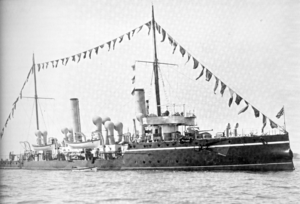Alarm-class torpedo gunboat
 HMS Jason | |
| Class overview | |
|---|---|
| Name: | Alarm-class torpedo gunboat |
| Builders: |
Naval Construction & Armament, Barrow Laird Brothers, Birkenhead Devonport Dockyard Sheerness Dockyard Thornycroft, Chiswick |
| Operators: |
|
| Preceded by: | Sharpshooter-class torpedo gunboat |
| Succeeded by: | Dryad-class torpedo gunboat |
| Built: | 1892–1893 |
| In commission: | 1893–1924[1] |
| Completed: | 11 |
| Lost: | 3 |
| Scrapped: | 8 |
| General characteristics [1] | |
| Type: | Torpedo gunboat |
| Displacement: | 810 tons |
| Length: | 242 ft (74 m) |
| Beam: | 27 ft (8.2 m) |
| Draught: | 12 ft 6 in (3.81 m) maximum |
| Installed power: | 3,500 ihp (2,600 kW) (except Speedy - 5,000ihp) |
| Propulsion: | Twin 3-cylinder vertical triple-expansion steam engines Locomotive boilers |
| Speed: | 18.7 kn (34.6 km/h) |
| Complement: | 91 |
| Armament: | Jason, Hebe, Circe, Onyx, Leda:
Alarm, Jaseur, Niger, Reynard, Speedy, Antelope:
|
The Alarm-class torpedo gunboat was the penultimate class of torpedo gunboat built for the Royal Navy. The class was contemporary with the early torpedo boat destroyers, which were faster and better suited to accompanying the battlefleet. By World War I the class had either been sold, converted to submarine depot ships or minesweepers, or reduced to harbour service. Three of the class were lost during World War I while serving in the minesweeping role.
Design
The Alarm class was designed by Sir William White in 1889 as an enlarged version of his previous Sharpshooter class. They had a length overall of 242 ft (74 m),[1] a beam of 27 ft (8.2 m)[1] and a displacement of 810 tons.[1] They were engined with two sets of vertical triple-expansion steam engines, two locomotive-type boilers, and twin screws. This layout produced 3,500 indicated horsepower (2,600 kW),[1] giving them a speed of 18.7 knots (34.6 km/h) with forced draught.[1] They carried between 100 and 160 tons of coal and were manned by 91 sailors and officers.[1]
Thornycroft Special - HMS Speedy
While officially classed with the Alarm class, the Speedy was actually a separate design. The Naval Defence Act of 1889 authorised the purchase of an Alarm-class torpedo gunboat built to a design by John I. Thornycroft & Company and built in their yard at Chiswick. Speedy was a three-funnelled vessel (compared to the two-funnelled Admiralty design), but the key difference was the use of water-tube boilers instead of locomotive-type boilers; she produced at least 5,000 indicated horsepower (3,700 kW) and could make 20.5 knots (38.0 km/h). The use of water-tube boilers was a key feature of the new torpedo boat destroyers that would make torpedo gunboats (including the Alarm class) obsolete.
_launch.jpg)
Armament
At build the class was fitted with two QF 4.7-inch (12 cm)/45-pounder guns, four 3-pounder guns and one Gardner machine gun. Five 14-inch (360 mm) torpedo tubes were fitted in the first five vessels, but this was changed to three 18-inch (450mm) torpedo tubes in the rest of the class. They were arranged as a pair of revolving deck mounts, a pair of fixed deck mounts (deleted in the later vessels) and a single bow-mounted tube; three reloads were provided.[1]
Ships
| Name | Ship Builder | Launched | Fate |
|---|---|---|---|
| Jason | Naval Construction & Armament, Barrow | 14 May 1892 | Became a minesweeper in 1909. Sunk by a mine off the west coast of Scotland on 7 April 1917 |
| Circe | Sheerness Dockyard | 14 June 1892 | Became a minesweeper in 1909. Sold for breaking on 30 July 1920 |
| Hebe | Sheerness Dockyard | 15 June 1892 | Became a minesweeper in 1909. Became a depot ship for submarines in 1910 (guns retained). Sold for breaking on 22 October 1919 |
| Onyx | Laird Brothers, Birkenhead | 7 September 1892 | Became a depot ship for submarines in 1907 (armament removed). Renamed Vulcan II in June 1919 (or April 1920?). Sold for breaking in August 1924 and resold on 9 October 1924 |
| Leda | Sheerness Dockyard | 13 September 1892 | Became a minesweeper in 1909. Sold for breaking on 14 July 1920 and broken up in Germany in 1922 |
| Alarm | Sheerness Dockyard | 13 September 1892 | Sold for breaking on 9 April 1907 |
| Jaseur | Naval Construction & Armament, Barrow | 24 September 1892 | Sold on 11 July 1905 |
| Renard | Laird Brothers, Birkenhead | 6 December 1892 | Sold for breaking on 4 April 1905 |
| Niger | Naval Construction & Armament, Barrow | 17 December 1892 | Became a minesweeper in 1909. Torpedoed by U-12 off Deal on 11 November 1914 |
| Speedy | Thornycroft, Chiswick | 18 May 1893 | Became a minesweeper in 1909. Sunk by a mine off the Humber on 3 September 1914 |
| Antelope | Devonport Dockyard | 12 July 1893 | Reduced to harbour service in 1910 and used as training ship at Devonport. Sold for breaking on 27 May 1919 |
See also
![]() Media related to Alarm class torpedo gunboat at Wikimedia Commons
Media related to Alarm class torpedo gunboat at Wikimedia Commons
References
- Colledge, J. J.; Warlow, Ben (2006) [1969]. Ships of the Royal Navy: The Complete Record of all Fighting Ships of the Royal Navy (Rev. ed.). London: Chatham Publishing. ISBN 978-1-86176-281-8. OCLC 67375475.
| ||||||||||
.jpg)